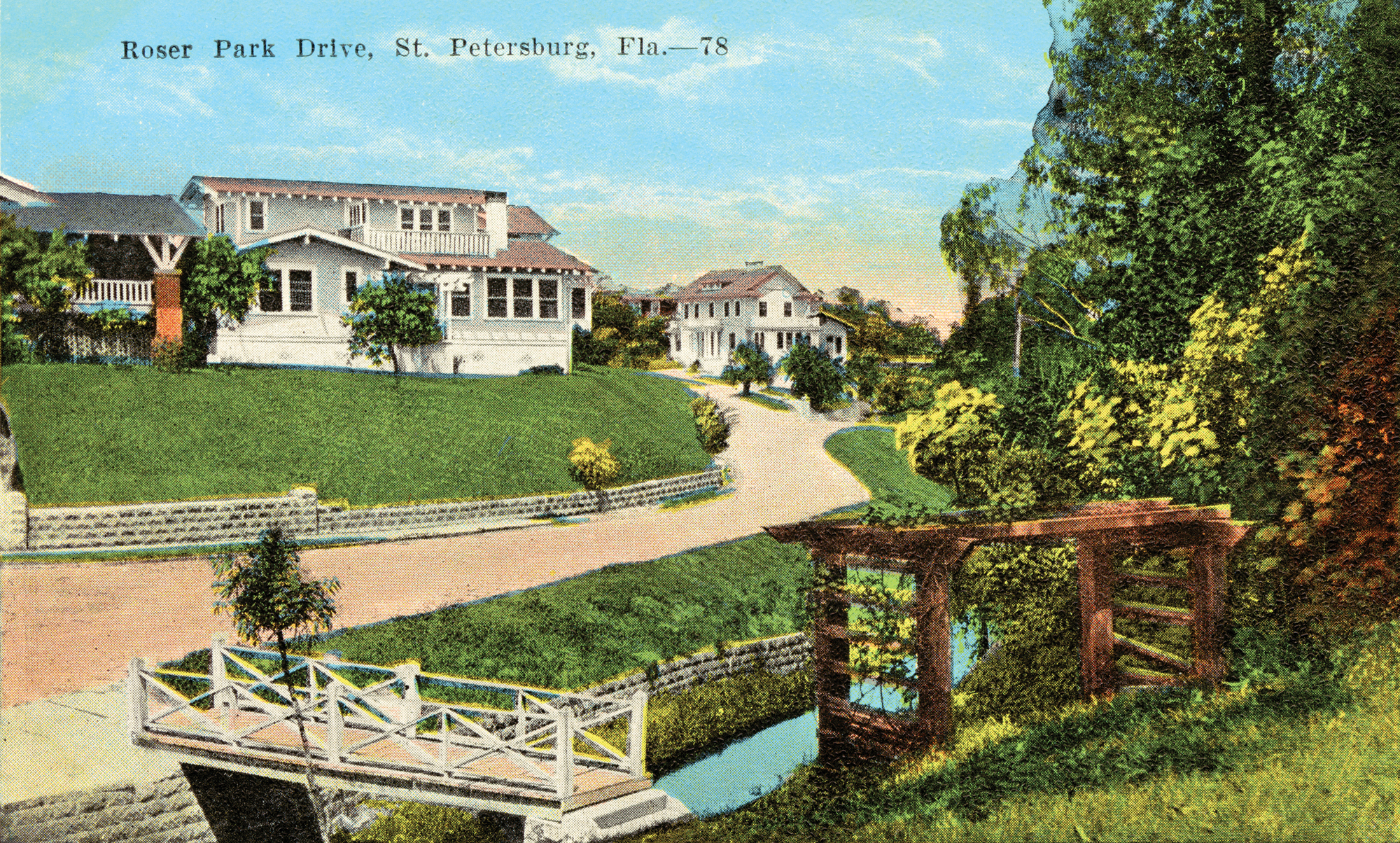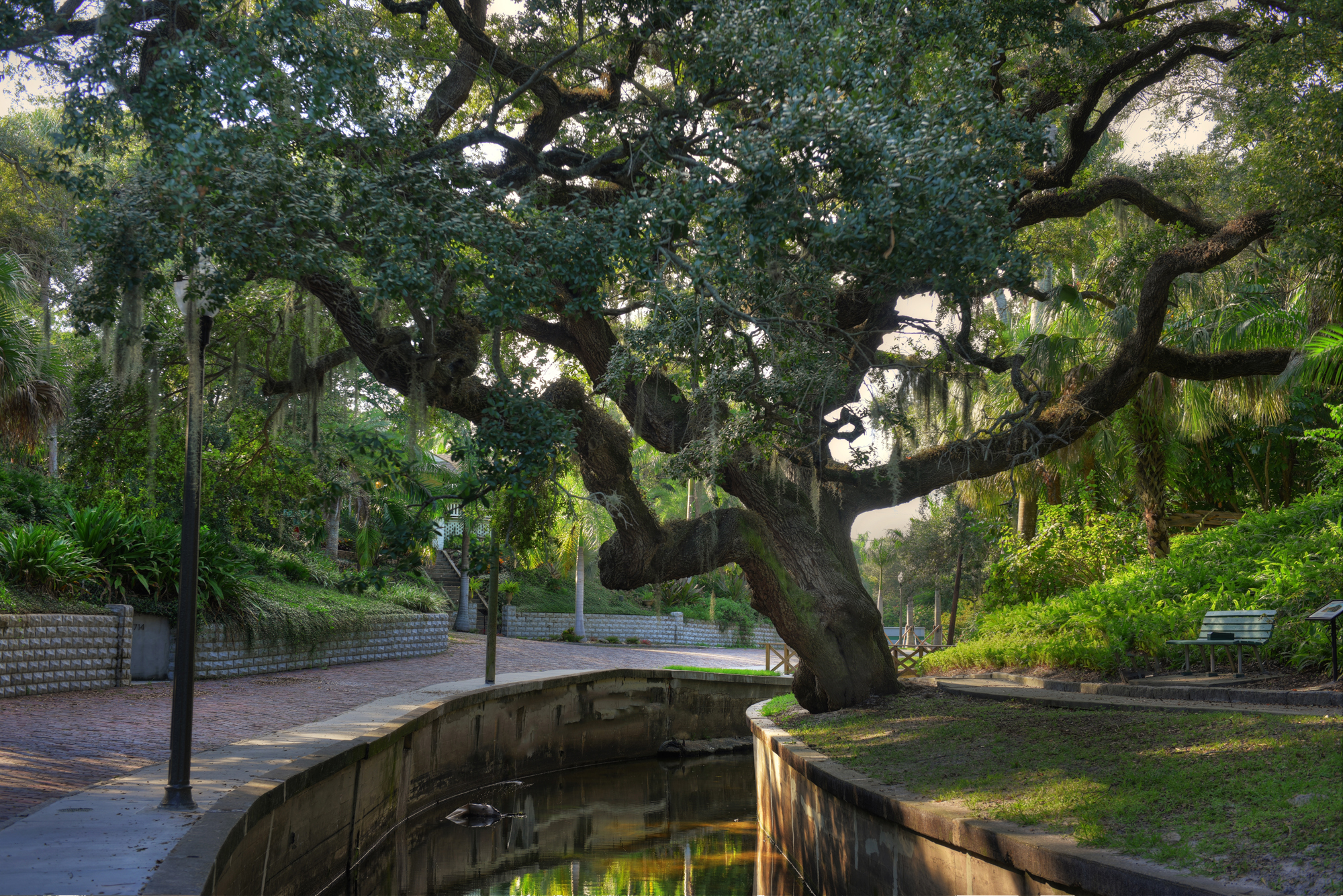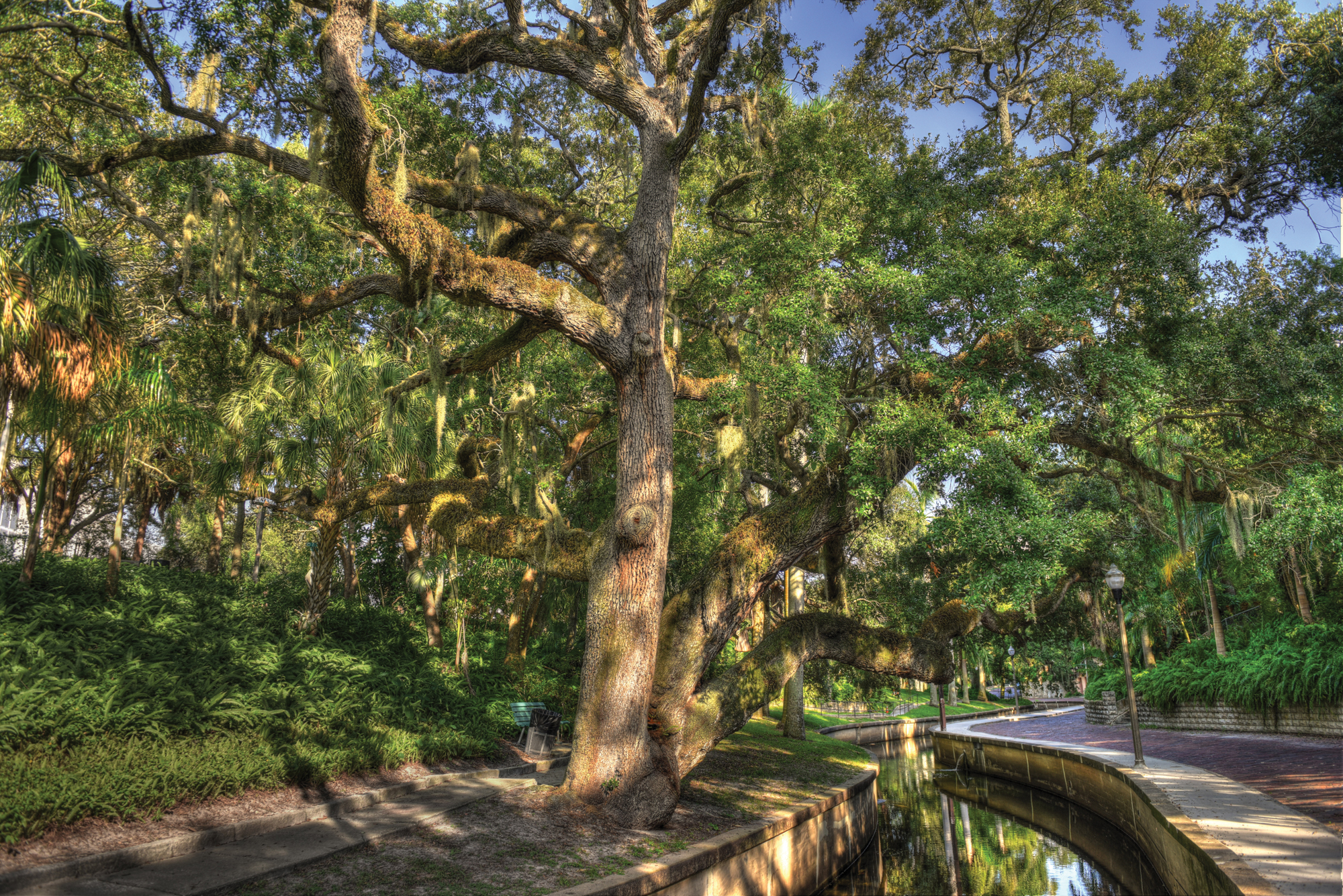Have you ever heard of Roser Park or even know where or what it is? I happened upon it one day, quite by accident after making a wrong turn. I had heard it mentioned over the years and figured it was just another one of St. Petersburg’s many neighborhoods. Southbound on Dr. Martin Luther King Street, I made a forced left onto 7th Avenue South when the lane I was in ended, but another vehicle kept me from changing lanes. “Okay,” I thought, “I can just take this down to 4th Street,” but I soon found it didn’t go through. Rather, it turned right onto Roser Park Drive South and crossed 8th Street South.
I was amazed to find myself on a hill, in an area of the city that was far different from anyplace else in the city. On my left was a concrete-lined creek, complete with footbridges. It was as though I had gone back to a quieter time in a beautiful park-like setting, surrounded by old homes built in a variety of styles: craftsman, bungalow and several revival styles, Mediterranean, colonial and Tudors, among others.
These beautiful old houses had for the most part been lovingly restored. I later found out that within the neighborhood’s 270 acres, there are 173 historic structures. The Roser Park Neighborhood—found roughly between 4th Street and 9th Street (MLK) to the east and west, and Booker Creek and Ingleside Avenue (11th Avenue South) to the north and south— was added to the National Historic Register in 1987.
Entranced by the historic nature of the area, I wandered the narrow, brick streets in my car at idle speed to enjoy the different styles of homes built on the well-shaded streets. Eventually, I came upon an old cemetery and stopped to wander among the tombstones. Among the headstones were veterans from both sides of the Civil War. There are two virtually identical monuments, which were erected in 1900, one for the Confederates and the other for the Union side. I found the name was Greenwood Cemetery, and later learned that in addition to the Civil War veterans, St. Petersburg’s first mayor and the man who developed Bayboro Harbor are both buried here, among many other pioneers and notable residents from the early days of our city.

Back in my car, I continued my wanderings until I came back upon the meandering Booker Creek, which played a large part in the development of the area. A pleasant walkway follows along the stream. I just had to grab the camera I keep in the glove compartment and get out of my auto again to take a closer look. Crossing one of the footbridges, I followed the walkway for a while and came upon a wooden sign that said Roser Park, which stood in front of a green hillside with shaded benches.
It was such a pleasant spot that I decided to stop and sit for a while and just enjoy the peaceful scene. Maybe five or ten minutes went by when a tall, dark-haired woman about my own age stopped in front of me and said, “Lovely spot isn’t it? I would guess by the camera around your neck you’re a visitor.”
“Good guess,” I responded. “Actually, I’ve been writing a series of articles about the history of St. Petersburg for a new magazine called Green Bench Monthly that you may soon find in your mailbox. Roser Park is such a little-known but historic area, and I’m certain people would find it very interesting.”
She replied, “I’ve lived in this area since 1985, when many of the beautiful homes you see were just barely standing. In time, new people who could see the potential of this area started to move into these old homes and renovate them. Some of these homes you see were bought for under $100,000, and most now sell for three to five times that much. You said you were interested in our history. I have a bit of time and am always happy to talk about our neighborhood. How far back would you like me to go? I could start with 12,000 years ago, when indigenous Indians made their camp along Booker Creek, as it provided them with a supply of fresh water.”

With that she took a seat on the bench. Surprised, I thought for a minute, “That would be great, but maybe we should just start around the time St. Petersburg started to expand out into this area.”
She paused for a while, thinking, and began, “Well, the area was developed by Charles Martin Roser, who moved here from Ohio, where he owned a cookie factory that made a fig cookie that may have become Nabisco’s Fig Newton. Legend has it that Roser sold his factory and rights to the cookie to Nabisco for a million dollars, which would equal around 19 million dollars today. Nabisco actually claims the cookie was invented by a Philadelphian named James Henry Mitchell, but since there were over 100 bakeries that were incorporated into Nabisco around that time, the company admits that it is possible that Roser was involved in the cookie’s creation. We’ll never know for sure.”
She went on to tell me how after selling his cookie factory, Roser moved to St. Petersburg in 1910 and established himself as a promoter, developer and philanthropist. Among his contributions were Mercy Hospital for the area’s black residents and the home for nurses at Mound Park Hospital, which became Bayfront Medical Center. He began work on the Roser Park subdivision in 1911 when he purchased a 10-acre citrus grove for $12,000, and continued adding to his holdings by buying up additional parcels in the next few years. However, many people thought he would not be able to make a go of it, saying, “No one would drop money into that mud hole.”
The woman continued her story, “But they were wrong! By 1913, Roser’s subdivision had grown to include 80 homes, including his own mansion at 7th Avenue and 7th Street South.”
She went on to tell me that he also bought up five additional acres along 9th and 6th Streets South, and gifted much of this land, including Booker Creek, to the city in 1918. The newspapers of the day said that Roser was always spending money on the neighborhood, including the park, streets and nurses’ home (Roser Hall), and never accepted any money from the city. After living out his years in the beautiful subdivision he built, Charles Roser died at Mound Park Hospital in 1937 at age 73.
The woman concluded, “Over the years, with downturns in the economy, many of the old homes fell into disrepair, and in the early 1980s, some who wandered into the area thought they would not be comfortable walking these streets at night. Then around 1989, the turnaround began, and continued until it has become the wonderful neighborhood you see today. There is no place on this earth I would rather be. Well, nice talking to you, but I better be getting home.”
I thanked her for her time and asked, “How do you know so much about the history of Roser Park?”
“We have a great neighborhood association that has their own website, www.historicroserpark.org, where I learned much of what I know on the subject. You should visit it, too.”
With that she excused herself and walked away, while I returned to my car, spent a few more minutes driving around the area, and headed home. I thought to myself how much I enjoyed my own neighborhood, but Roser Park is a really special place.



